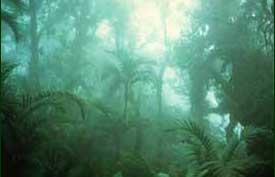Foreword
This site is under redevelopment. Its content is from 1998, but we will be updating it in the near future.
It was a great experience for me to conduct field work from the 1950s through the 1970s in tropical rain forest in its pristine state on the Philippine islands of Bohol, Mindanao, Mindoro, Negros and Palawan. At that time, the old growth lowland rain forest still existed at sea level; large trees with huge buttresses and straight boles towered to 30m or more to form the tallest story. The crowns of the lower tree strata formed a continuous forest canopy, effectively preventing light rays from penetrating to the forest floor, except in areas where the canopy was broken by fallen trees. Climbing bamboos, rattan, tree ferns, palms, and lianas were abundant. Many ferns, aerial mosses, and orchids grew on tree trunks. The forest floor was often covered with decaying vegetation and leaf litter, harboring a rich assemblage of small animals and lower plants.
Beginning at about 1,000 meters, we saw montane forest trees that were shorter and heavily encrusted with mosses. This forest abounded in aerial ferns and screw pines, the latter growing so thick that they impeded human movement. The montane rain forest was always wet because of year-round rainfall, storing enormous volumes of water, and humidity was always high, from 70-100%, even during dry periods. The complex forest structure provided for a large number and variety of animal microhabitats. The relative quiet in the forest during the day was frequently broken by animal calls and sounds of animal movements and the occasional breaking of twigs and branches. It was a different story at night, when we heard a symphony of sounds made by birds, frogs and insects.
In the Philippines, biodiversity and natural history are tightly interlinked with geological history. Once difficult to explain, the presence of a host of unique and endemic plant and animal species is rendered somewhat easier to understand today by the advances in our knowledge of land connections, movements and break-up of continents, formation of oceanic islands through tectonic events, and evolutionary processes leading to specialized niches of organisms in the tropics where temperatures show almost no variation throughout the year. There is great diversity in the geological history Among the Philippine islands. Luzon and Mindanao, for example, have large areas that are more than 25 million years old, while the others are generally of more recent age, from 10 million to no more than 100,000 years. Most islands are oceanic in origin, but Palawan, Mindoro and Panay have an Asiaticcontinental component. More recently, the development of glaciers in polar regions about 20,000 years ago and 160,000 years ago, which lowered the sea level by 120m or more, would have created five major islands - namely Greater Sulu, Greater Palawan, Greater Negros-Panay, Greater Mindanao and Greater Luzon -- and joined Palawan with Borneo, but it would not have closed the gaps between Borneo and Greater Sulu and Greater Mindanao, or Greater Mindanao and Greater Luzon. In geologic and biogeographic terms, Palawan is not part of the Philippines but of the Greater Sunda Islands (Borneo, Java and Sumatra), which were at times dry-land extensions of the Indochina-Malay region.
This diverse geological history provides an ideal opportunity to study evolution in action. Aside from evolutionary mechanisms promoting speciation in the rain forests, the partitioning of the Philippines into islands separated by sea barriers has contributed to the formation of endemic species (those that are unique to some specific area) through geographic isolation, thus preventing interbreeding. On large islands, populations have been isolated on mountain peaks separated by swaths of lowlands that also prevented gene flow. Resolving the details of many issues concerning biodiversity in the Philippines remains a great challenge, and will require further field and laboratory studies. Much remains to be learned.
The number of plant and animal species in the Philippine rain forest is incompletely known. There are an estimated 13,500 plant species, of which about 8,000 are flowering plants; about 3,200 are endemic. Philippine land vertebrate species number about a thousand: approximately 80 amphibians, some 240 reptiles, 556 birds (resident and migratory), and 174 mammals. These numbers will certainly be revised upwards as new species are still being discovered. In fact, we have described eight new species of forest frogs in a space of five years and Dr. Lawrence Heaney and his colleagues have reported 16 new mammal species during the last ten years. It is the exceptionally high level of endemism that is now attracting international attention. Seventy-five percent of the amphibians, 70 percent of reptiles, 44 percent of birds, and 64 percent of mammals are found nowhere else inthe world. Dr. Heaney believes that Philippine mammals have the highest percentage of species endemism in the world on a hectare-for-hectare basis, and this could be true for other groups as well.
The Tropical Rain Forest has supplied indigenous Philippine peoples with a treasure trove, including lumber, food, drinks, spices and medicine. It is to the credit of these indigenous human communities that they have used forest resources in a sustainable way. But it is a sad fact that today only remnants of this forest can be found, mostly in less accessible parts of the Philippines, especially in mountainous areas. In 1934, the total forested area was estimated at 17 million hectares, or 57% of the country s total land area of 30 million hectares. But in 1993, the area was reduced to 5.7 million hectares, or 19% of the land area, and most was secondary forest. The primary or original tropical lowland forest was only 872,000 hectares, the logged-over lowland forest about three million hectares, and the montane forest about a million hectares. Thus, only about 1.87 million hectares, about 6percent, have remained as prime habitats of wildlife. The immediate reasons for the drastic reduction of the primary forest area are large-scale logging and conversion to agriculture, and are strongly associated with the rapid increase in human population, reaching about 70 million in 1997. Over 15 million upland people today threaten the survival of the remaining forests, despite government effort at protection.
A large number of endemic species in the Philippine tropical rain forest and the forest itself are now threatened with complete destruction, making the country a “hot spot”, that is, an area where there is a high probability of species extinctions. Already some 52 native vertebrate species are in the critical or endangered categories, and a great many more are listed as threatened. The frog Platymantis spelaeus and the fruit bat Dobsonia rabori are almost surely extinct, and another frog, a bushy-tailed cloud rat, and at least one species of bird are probably extinct as well. Most endemic land vertebrates (including birds, small arboreal frogs, and many mammals) require primary-forest habitats and fail to survive in highly disturbed and secondary forests. Preservation of the primary rainforest is therefore a high priority for the Filipino people.
This book, which is published in connection with the Field Museum exhibits to commemorate the Philippine Centennial in 1998, is indeed a significant contribution. The authors have described the vanishing treasures of our Philippine tropical rain forest in both words and images. Both authors, being scientists with long research experience in the Philippines, are eminently competent to present the case for these treasures to the readers. Drs. Heaney and Regalado deserve our commendation for writing this book with a broad audience in mind and for reminding us how much humankind will lose if the Philippine tropical rain forest is not preserved. It is my hope that through this book, readers will better understand and appreciate the role of the Philippine tropical rain forest, its biodiversity, and their impact on human affairs and that, as a result, they will contribute resources to thepreservation of this forest, which still holds many secrets for us and future generations to unravel.
ANGEL C. ALCALA, Ph.D.
Chairman
Commission on Higher Education
Republic of the Philippines

